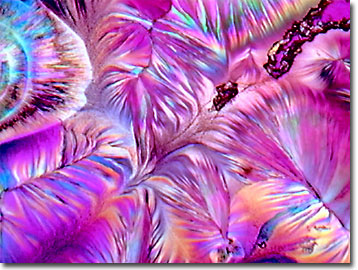Polarized Light Digital Image Gallery
Serotonin
A monoamine neurotransmitter, serotonin involves many sensory and higher centers in the brain including memory, appetite, sleep, and learning. Known to many as the "feel good" hormone, serotonin, along with endorphins, GABA, and dopamine, form the biological process known as the reward cascade.

View a second image of serotonin.
With a molecular weight of 176.2, the melting point is 167 to 168 degrees Celsius and the synthesized form of serotonin is often sold as a solid with the addition of a hydrochloride group (HCl). The name "serotonin" plays to the 1930s research on the organic compound as a vascular and gastrointestinal contractile agonist in blood that, as a powerful serum vasoconstrictor, induces muscle tone.
The physiological complexities of this neurotransmitter depend in part on the numerous 5-HT receptors in the central nervous system and the periphery. Many pharmaceuticals depend on inhibiting serotonin uptake such as the monoamine oxidase inhibitors and selective serotonin reuptake inhibitors (such as Prozac), or stimulating serotonin production to alter moods and fight depression. By keeping serotonin in the synaptic cleft longer and out of the presynaptic axonal terminal, Prozac and related drugs help maintain an elevated mood. Appetite-reducing drugs, such as the controversial dexfenfluramine (Redux), elevate serotonin levels in the brain while other formulations are designed to increase cravings and dietary intake through reducing serotonin levels. The infamous hallucinogen LSD distorts perception by binding to one type of serotonin brain receptor in the cerebral cortex.
Natural sources of serotonin include animals, fruits, nuts, and other plant materials. In the human body, serotonin is biosynthesized from the amino acid tryptophan. The herbal remedy, St. John's wort is supposed to increase the endogenous production of serotonin. Abusing the illegal drug ecstasy (methylenedioxymethamphetamine or MDMA) causes a severe depletion in the amount of serotonin in the brain by continually stimulating neurons to release serotonin. Ecstasy users report an increased awareness of emotion and a heightened sense of intimacy that is related to serotonin neurotoxicity. The low experienced following the drug's use relates to depleted serotonin supplies, mimicking depression. Serotonin is produced in the gastrointestinal system and transmitted via the blood stream to the body's nerve cells. It also acts as a precursor to melatonin in the pineal gland where it is important in the regulation of sleep and circadian rhythms.
Contributing Authors
Omar Alvarado, Thomas J. Fellers and Michael W. Davidson - National High Magnetic Field Laboratory, 1800 East Paul Dirac Dr., The Florida State University, Tallahassee, Florida, 32310.
BACK TO THE POLARIZED LIGHT IMAGE GALLERY
BACK TO THE DIGITAL IMAGE GALLERIES
Questions or comments? Send us an email.
© 1995-2025 by Michael W. Davidson and The Florida State University. All Rights Reserved. No images, graphics, software, scripts, or applets may be reproduced or used in any manner without permission from the copyright holders. Use of this website means you agree to all of the Legal Terms and Conditions set forth by the owners.
This website is maintained by our
Graphics & Web Programming Team
in collaboration with Optical Microscopy at the
National High Magnetic Field Laboratory.
Last Modification Friday, Nov 13, 2015 at 02:19 PM
Access Count Since September 17, 2002: 14018
Visit the website of our partner in introductory microscopy education:
|
|
